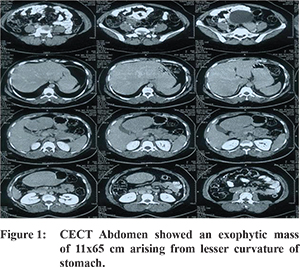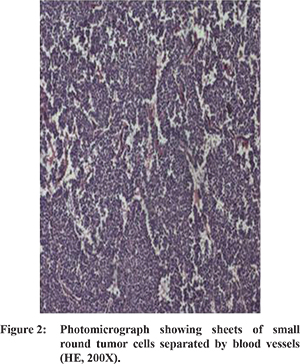48uep6bbphidcol2|ID
48uep6bbphidvals|1721
48uep6bbph|2000F98CTab_Articles|Fulltext
Ewing’s sarcoma (ES) is a small round cell tumor that arises most commonly in bones, and may occasionally originate in soft tissues. Extraskeletal Ewing’s sarcoma (ESS) has the same genetic origin as ES, and may involve any part of body such as small bowel, vagina, esophagus, pancreas or kidney.
1 It is relatively rare foran Ewing’s sarcoma / Peripheral Neuroectodermal Tumor (PNET) to arise from the stomach. Only six cases of gastric ES/PNET have been previously reported.
Case Report
A 32-year-old female presented with complaints of pain upper abdomen and loose stools since 2 months ago. CECT Abdomen showed an exophytic mass of 11x6.5 cm arising from the lesser curvature of the stomach (Figure 1). A case of GIST was suspected. Exploratory laparotomy with excision of mass was done. Histologic examination of the excised mass revealed undifferentiated small round cells arranged in groups and along blood vessels with mild pleomorphism, inconspicuous nuclei and scanty mitosis (Figure 2). Strong membranous CD 99 positivity was noted by immuno histo chemistry (IHC), which is essential for diagnosis of ES.2 Vimentin was also found to be strongly positiveon IHC. S-100 showed focal positivity. Synaptophysin, chromogranin A, NSE, PLAP, AFP, inhibin, caretinin and desmin were negative. After surgery, PET scan showed an ill-defined nodular lesion in left breast upper outer quadrant showing low grade FDG uptake which was adjudged to be most likely benign. There were no other significant findings. The patient was given six courses of adjuvant chemotherapy comprising epirubicin (100 mg), cyclophosphamide (1000 mg) and vincristine (2mg) intravenously. Patient tolerated all cycles of chemotherapy well. After 6 courses of chemotherapy, PET scan showed a nodular lesion in deep subareolar region with increased FDG uptake. No abnormal FDG uptake was noted in stomach. Mammograph showed calcification in left breast. Biopsy from breast lesion was taken and was found to be negative for malignant cells. At present, patient is disease free after 1 year of surgery and is on regular follow up.


Discussion
Ewing sarcoma and PNET are two variants of the same tumor. They differ only in the degree of neural differentiation. Both have similar neural phenotype, surface marker protein (CD99) and share an identical chromosome translocation - most commonly t(11;22).Tumors that demonstrate neural differentiation are labeled PNETs, while the rest are diagnosed as Ewing sarcoma1. The two diseases are now treated as a single entity.
Strong membranous CD 99 is essential for the diagnosis of ES/PNETs. Antibody to CD99 has been strongly positive in 90 - 100% of cases reported to be ES/PNETs.2 All six reported cases of gastric ES/PNETs also revealed the diagnostic significance of CD99. Vimentin which is an intermediate filament that is present in most mesenchymal cell is also usually positive in ES/PNET cells.
1 The six reported cases of gastric ES/PNETs also showed positive vimentin expression in tumor cells. In ES/PNET, various neural markers such as S100, chromogranin A, synaptophysin and neuron-specific enolase (NSE) shows variable immunohistochemical staining which may be due to the differing degrees of neuroectodermal differentiation in the individual tumors.
1 Surgical resection was possible in all six reported cases of gastric ES/PNETs. The current standard chemotherapeutical treatment for ES/PNETs is a regimen comprising the drugs: vincristine, doxorubicin, cyclophosphamide, ifosfamide and etoposide. Chemotherapy has a curative role in the management of localized ES/PNET but its role in metastatic disease is limited.
3,4 Combined modality treatment comprising of surgery, multi agent chemotherapy and radiation therapy improves survival in metastatic ES/ PNET.
5
Refernces
- El Weshi A, Allam A, Ajarim D, Al Dayel F, Pant R, Bazarbashi S, et al. Extraskeletal Ewing’s sarcoma family of tumours in adults: analysis of 57 patients from a single institution. Clin Oncol (R CollRadiol). 2010;22:374-381.
- Ramani P, Rampling D, Link M. Immunocytochemical study of 12E7 in small round-cell tumours of childhood: an assessment of its sensitivity and specificity. Histopath. 1993;23:557-561.
- Leavey PJ, Collier AB. Ewing sarcoma: prognostic criteria, outcomes and future treatment. Expert Rev Anticancer Ther. 2008;8:617-624.
- Esiashvili N, Goodman M, Marcus RB Jr. Changes in incidence and survival of Ewing sarcoma patients over the past 3 decades: Surveillance Epidemiology and End Results data. J Pediatr Hematol Oncol. 2008;30:425-430.
- Haeusler J, Ranft A, Boelling T, Gosheger G, Braun-Munzinger G, Vieth V,et al. The value of local treatment in patients with primary, disseminated, multifocal Ewing sarcoma (PDMES) Cancer. 2010;116:443-450.